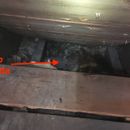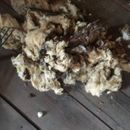Spray Foam Attic: Is blocking at the eaves required?
Closed-cell attic spray foam, climate 4A, balloon frame 1924 house, dense pack cellulose already in walls. As I’m trying to prep the attic prior to the insulation, I am also trying to educate myself on some of the specifics so I will be able to get my preferences spelled out in the eventual contract. Often times details are left out and left up to the contractor. Part of the steepness of the learning curve is that if you’ve never studied wood-framing or observed your house’s framing up close it’s hard to visualize how things are actually laid out.
I had assumed that after the existing fiberglass insulation was removed, the foam would go all the way to the edge of the contained space–meaning past the top plate (two double 2x4s that define the edge of the house wall– and into, in my case, a fairly shallow overhang/soffit area ending in the fascia board. 4-5inches to my eye–we have a small overhang.
But from what I have learned on this site and others, blocking with various kinds of board is often applied–probably easier from the outside if it was open at the time–but that would also have to be covered from the inside with gypsum board or some other thermal barrier for fire protection. The two reasons this seems to be the case is a)the fascia board often has cracks in it from age or shrinkage, and if the foam is sprayed that far it will seep out the crack and possibly cause a huge mess that the contractor will have to clean up; b) the contractor doesn’t want to pay for the extra foam into the soffit area that is likely not necessary since it is outside the envelop of the building.
The contractors we have spoken to–all very experienced and professional–do not plan to use blocking. They will remove much of the exposed fiberglass–see attached photos–and probably intend to leave the balance past the top plate to act as blocking. It was pointed out to me by an experienced GC that that insulation should never have been stuffed into the edges like that and could have resulted in rot due to moisture buildup if the house hadn’t been so open otherwise. To my eye the pile of removed fiberglass shows no signs of rot, just the signs of decades of cold and heat. The black you may see is shreds of the backing paper.
Note the grey arrow in the diagram pointing to the same area as my photo shows.
So my questions are:
1-Is using the old insulation as blocking ok? Or should it be removed to prevent moisture buildup etc. and then the residual dust be vacuumed out to allow greater adhesion by the spray foam?
2-Should the spray foam only go a few inches past the outer edges of the top plate?
GBA Detail Library
A collection of one thousand construction details organized by climate and house part












Replies
David,
Your attic won't need ventilation once the spray foam is installed, because you are creating a conditioned attic. So you don't need ventilation baffles to allow air to flow from your soffit to your attic. This area can be foamed.
The fiberglass insulation in your soffit is harmless and can be left in place. It will serve fine as backing for the closed-cell spray foam. Just make sure (1) That you can see the top plates of the walls, ensuring that the spray foam covers the top plates, and (2) That the spray foam is installed in a thick enough layer (say, 2 to 4 inches minimum) in this area to be structurally strong enough so that there are no worries that the foam will be breakable after the foam has cured.
-- Martin Holladay
Thanks Martin. Didn't mean to give the impression i was talking about ventilation baffles from soffit, just wondering what to do about any space between the end of the spray foam after the top plate and the soffit/fascia. Apparently leaving the insulation in between top plate--or just a little past--as blocking is ok. We decided to go R-38 which will be a little over 5 inches. We also are opting for the DC 315 coating for the thermal break instead of the sheetrock due to cost as well as thermal bridging as long as we can be assured that the DC 315 is approved for the assembly with the particular foam the contract will use. I had heard that that Demilec -made coating is an approved thermal barrier with Demilec spray foam but still trying to verify that's true with other foams as well.
The contractor has said he'll either use the existing insulation as blocking past the top plate or if we want to remove all the insulation from plate to soffit/fascia and caulk any fascia cracks he will fully insulate that area but can't be held liable for foam extrusions that may occur through the cracks.
I just want to say to you and the advisors on this site how valuable this site is to homeowners especially when we are in the midst of researching and trying to make informed decisions--well worth the subscription price. GBA is really at the cutting edge of the emerging knowledge in this field, which seems to grow on a daily basis. Thanks for all the time you put in helping us out.